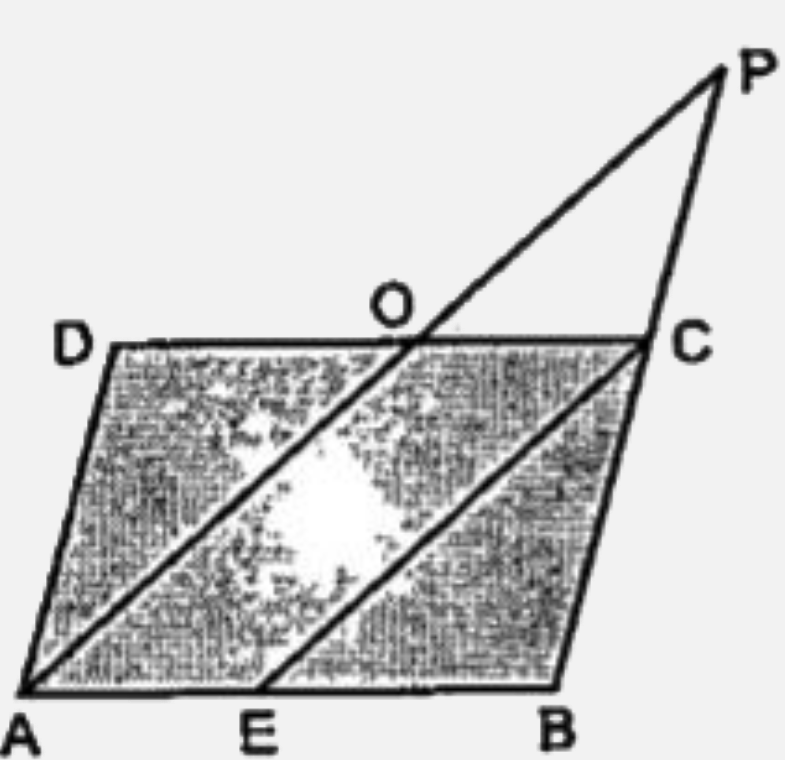In parallelogram ABCD, E is mid-point of CD and through D, a line is drawn parallel to EB to meet CB produced at point G and to cut AB at point F. Prove that :
DG = 2EB
To prove that DG=2EB in the given parallelogram ABCD with E as the midpoint of CD, we can follow these steps:
Step 1: Understand the configuration
- We have a parallelogram ABCD.
- E is the midpoint of side CD.
- A line is drawn through point D parallel to line EB which intersects the extended line CB at point G and line AB at point F.
Step 2: Apply the properties of parallelograms
- In parallelogram ABCD, we know that opposite sides are equal and parallel, i.e., AB∥CD and AD∥BC.
Step 3: Use the Midpoint Theorem
- According to the Midpoint Theorem, if E is the midpoint of CD and DG is parallel to EB, then by the converse of the Midpoint Theorem, B must be the midpoint of CG.
Step 4: Establish relationships using the Midpoint Theorem
- Since E is the midpoint of CD, we can denote CE=ED.
- Since B is the midpoint of CG, we can denote BG=GC.
Step 5: Relate the segments
- From the properties established, we have:
EB=12DG
- Rearranging this gives us:
DG=2EB
Conclusion
Thus, we have proved that DG=2EB.
---
- We have a parallelogram ABCD.
- E is the midpoint of side CD.
- A line is drawn through point D parallel to line EB which intersects the extended line CB at point G and line AB at point F.
- In parallelogram ABCD, we know that opposite sides are equal and parallel, i.e., AB∥CD and AD∥BC.
- According to the Midpoint Theorem, if E is the midpoint of CD and DG is parallel to EB, then by the converse of the Midpoint Theorem, B must be the midpoint of CG.
Step 4: Establish relationships using the Midpoint Theorem
- Since E is the midpoint of CD, we can denote CE=ED.
- Since B is the midpoint of CG, we can denote BG=GC.
- From the properties established, we have:
EB=12DG
- Rearranging this gives us:
DG=2EB
Thus, we have proved that DG=2EB.
Topper's Solved these Questions
- CHAPTERWISE REVISION (STAGE 3) BOOK - ICSECHAPTER - CHAPTERWISE REVISION (STAGE 3) EXERCISE - PYTHAGORAS THEOREM
5 Videos
- CHAPTERWISE REVISION (STAGE 3) BOOK - ICSECHAPTER - CHAPTERWISE REVISION (STAGE 3) EXERCISE - RECTILINEAR FIGURES
6 Videos
- CHAPTERWISE REVISION (STAGE 3) BOOK - ICSECHAPTER - CHAPTERWISE REVISION (STAGE 3) EXERCISE - INEQUALITIES
7 Videos
- CHAPTERWISE REVISION (STAGE 1) BOOK - ICSECHAPTER - CHAPTERWISE REVISION (STAGE 1) EXERCISE - Graphical solution
10 Videos
- CIRCLEBOOK - ICSECHAPTER - CIRCLEEXERCISE - EXERCISE 17(D)
12 Videos
Similar Questions
In parallelogram ABCD, E is mid-point of CD and through D, a line is drawr parallel to EB to meet CB produced at point G and to cut AB at point F. Prove that:
2×AD=GC
View SolutionIn parallelogram PQRS. L is mid-point of side Sr and SN is drawn parallel to LQ which meets RQ produced prove that :

SN=2LQ
View SolutionIn parallelogram ABCD, E is the mid-point of AB and AP is parallel to EC which meets DC at point O and BC produced at P. Prove that:

PB=2AD
View SolutionIn parallelogram ABCD, E is the mid-point of AB and AP is parallel to EC which meets DC at point O and BC produced at P. Prove that :

BP=2AD
View SolutionIn parallelogram ABCD, E is the mid-point of AB and AP is parallel to EC which meets DC at point O and BC produced at P. Prove that:

O is mid-point of AP.
View SolutionIn parallelogram PQRS. L is mid-point of side SR and SN is drawn parallel to LQ which meets RQ produced prove that :

SP=12RN
View SolutionIn a trapezium ABCD, AB/DC, E is mid-point of aD. A line through E and parallel to AB intersects BC at point F. Show that:
2EF=AB+DC
View SolutionIn parallelogram ABCD, E is the mid-point of AD and F is the mid-point of BC. Prove that BFDE is a parallelogram.
View SolutionThe side AB of a parallelogram ABCD is produced to any point P. A line through A and parallel to CP meets CB produced at Q and then parallelogram PBQR is completed. Show that ar (ABCD) = ar (PBQR).
View SolutionIn triangle ABC, D and E are mid-points of the sides AB and AC respectively. Through E, a straight line is drawn parallel to AB to meet BC at F. Prove that BDEF is a parallelogram. If AB = 16 cm, AC = 12 cm and BC = 18 cm, find the perimeter of the parallelogram BDEF.
View Solution
